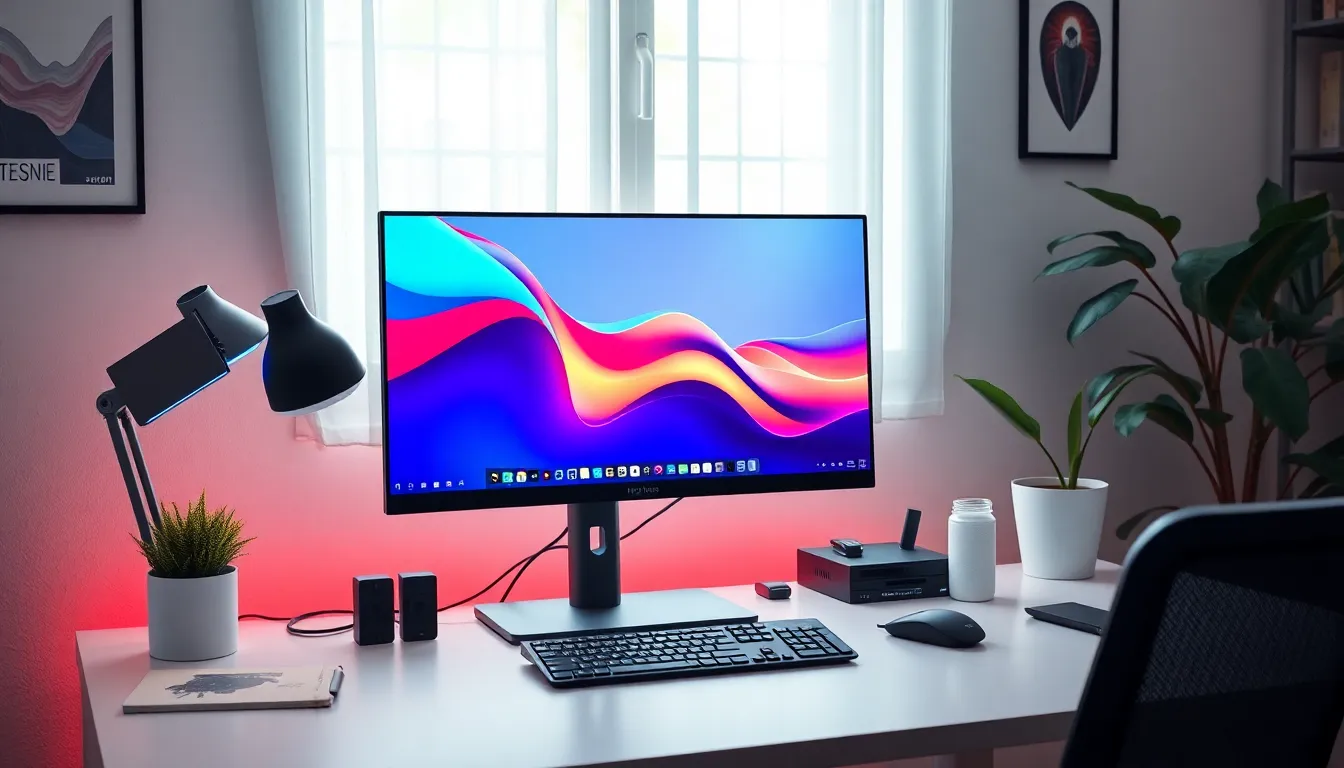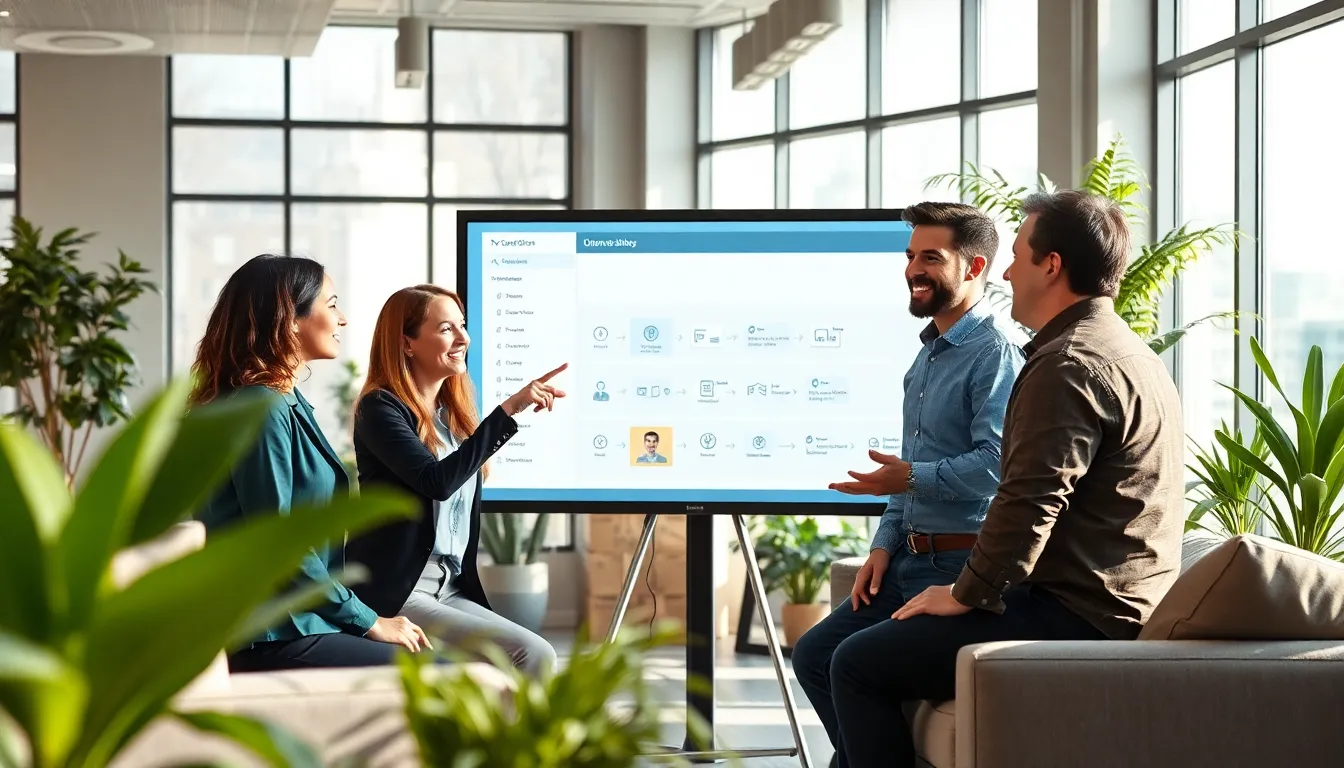In a world dominated by mobile devices, desktop computers continue to hold their ground as powerful workhorses for both personal and professional use. These machines offer unmatched performance, expandability, and versatility, making them essential tools for gamers, designers, and business professionals alike.
With a wide range of options available, from budget-friendly models to high-end gaming rigs, desktop computers cater to diverse needs and preferences. Their ability to handle demanding applications and multitask efficiently sets them apart, ensuring users can tackle everything from video editing to complex data analysis with ease. As technology evolves, desktop computers remain a cornerstone of computing, proving that sometimes, bigger is indeed better.
Table of Contents
ToggleOverview of Desktop Computers
Desktop computers represent a fundamental category in personal computing, characterized by their separate components. Desktops typically consist of a central processing unit (CPU), monitor, keyboard, and mouse, allowing for a versatile workstation setup.
Performance
Performance varies widely among desktop computers, ranging from basic machines for everyday tasks to high-performance systems for demanding applications. Budget models typically use entry-level processors, while high-end gaming rigs feature advanced multi-core CPUs and dedicated graphics cards.
Expandability
Expandability is a significant advantage of desktop computers. Users can easily upgrade components such as RAM, storage, and graphics cards. This adaptability extends the lifespan of the machine, making it easier to meet evolving computing needs.
Versatility
Versatility caters to a diverse range of users. Gamers benefit from customizable hardware configurations, designers utilize powerful graphic capabilities for rendering, and business professionals employ desktops for extensive multitasking. Each category of user finds suitable options that align with specific requirements.
Options Available
The options for desktop computers are extensive. They range from all-in-one PCs, combining components into a single unit, to traditional tower setups that allow for greater customization. Users can choose based on their preferences, performance needs, and budget constraints.
Multitasking Capabilities
Multitasking capabilities are vital for many users. Desktop computers manage multiple applications seamlessly, resulting in increased productivity. Higher RAM and faster CPUs enable efficient handling of simultaneous tasks, making desktops ideal for complex workflows.
Key Features of Desktop Computers

Desktop computers present a variety of key features that cater to different user needs. From performance specifications to design aesthetics, these elements significantly influence user experience and satisfaction.
Performance Specifications
Performance specifications determine a desktop’s capability to handle tasks. Key components include:
- Central Processing Unit (CPU): The CPU, especially multicore models, influences speed and multitasking capability. Options range from basic processors like Intel Core i3 for everyday tasks to high-end CPUs like AMD Ryzen 9 for demanding applications.
- Random Access Memory (RAM): RAM affects the ability to run multiple applications simultaneously. Standard configurations include 8GB for basic use and 32GB or more for gaming and graphic design.
- Storage Solutions: Desktop computers utilize both Hard Disk Drives (HDD) and Solid State Drives (SSD). SSDs offer faster performance, while larger HDDs provide more storage. Many systems combine both for optimal functionality.
- Graphics Processing Unit (GPU): The GPU is critical for graphics-intensive tasks and gaming. High-performance GPUs, such as NVIDIA GeForce RTX series, enhance rendering speed and visual quality.
Design and Aesthetics
Design and aesthetics play a crucial role in desktop computer selection. Considerations include:
- Form Factor: Choices range from traditional tower cases to smaller compact systems, catering to space requirements. All-in-one desktops integrate components into the monitor, offering a sleek design for limited spaces.
- Customization Options: Many desktops allow for aesthetic customization, including lighting options and case designs. Gamers often prefer RGB lighting and transparent panels to showcase hardware.
- Ergonomics: Ergonomically designed peripherals, like keyboards and monitors, enhance user comfort. Adjustable stands for monitors can prevent strain during prolonged use.
These features collectively create a powerful and adaptable computing environment suitable for various tasks and user preferences.
Types of Desktop Computers
Desktop computers come in various forms, each catering to specific needs and preferences. These options include all-in-one desktops, gaming desktops, and business desktops, each offering unique features and advantages.
All-in-One Desktops
All-in-one desktops integrate all components, including the CPU and monitor, into a single unit. These systems save space and reduce cable clutter, making them ideal for environments where aesthetics matter. Users choose all-in-one models for their sleek design and convenience. Performance varies, with options suitable for basic tasks like web browsing and document editing to more demanding applications, which may include photo editing and light gaming. Popular models often feature touchscreen interfaces, enhancing interactivity.
Gaming Desktops
Gaming desktops are designed specifically for high-performance gaming experiences. Equipped with powerful CPUs and dedicated graphics cards, these systems run demanding games at high settings. They often support advanced cooling solutions to maintain optimal performance during intense gaming sessions. Users typically customize gaming desktops to enhance graphics, speed, and storage capacity, ensuring they meet the latest gaming requirements. Aesthetics play a significant role, with RGB lighting and custom cases appealing to gamers’ preferences.
Business Desktops
Business desktops prioritize efficiency and reliability in professional environments. These systems commonly feature robust processors and ample RAM to support multitasking and demanding software applications. Security features, like hardware encryption and secure boot processes, are integral to business desktops. Users benefit from easy upgrades, allowing for extended usability as requirements change. These configurations typically focus on durability and energy efficiency, aligning with the needs of corporate settings.
Advantages of Desktop Computers
Desktop computers offer significant benefits that cater to a wide range of users. Their robust performance and upgradability distinguish them in the personal computing landscape.
Power and Performance
Desktop computers excel in power and performance due to their larger components and cooling systems. High-performance CPUs and dedicated GPUs allow desktops to manage demanding applications effortlessly. For example, gaming desktops often incorporate multi-core processors, enhancing frame rates and graphics rendering. Additionally, RAM capacity can reach 64 GB or more, enabling smooth multitasking across numerous applications. This performance is essential for professionals in graphic design, video editing, and engineering, where resource-intensive software requires ample processing power.
Upgradability
Upgradability represents a key advantage of desktop computers, allowing users to customize their systems easily. Users can replace or upgrade components such as RAM, storage drives, and graphics cards without purchasing an entirely new machine. For instance, upgrading to an SSD significantly boosts boot times and overall responsiveness. This flexibility extends the lifespan of desktops, accommodating evolving user needs and technological advancements. By investing in a customizable setup, users maintain their desktops as valuable and high-performing tools for years.
Disadvantages of Desktop Computers
Desktop computers present limitations that can impact usability for some users. Factors such as portability issues and space requirements must be considered when evaluating their practicality.
Portability Issues
Portability presents a significant drawback for desktop computers. Desktops require a dedicated workspace, making them less convenient for users who need computing on the go. They consist of multiple components—such as a CPU unit, monitor, keyboard, and mouse—making transport cumbersome. Users who travel frequently or work in multiple locations may find laptops or tablets more suitable for their needs. Additionally, setting up a desktop outside of its designated area typically involves considerable effort in connecting and organizing cables.
Space Requirements
Space requirements can limit the placement options for desktop computers. Desktops occupy more physical space than laptops or all-in-one systems, necessitating a designated desk or workstation. This limitation can be problematic in small living spaces or offices where every square foot counts. Users may also need to allocate additional space for peripheral devices and hardware upgrades, further complicating the setup. The need for adequate airflow around desktop components can also restrict placement, particularly in compact environments.
Desktop computers continue to hold their ground in a world increasingly dominated by mobile devices. Their unmatched performance and expandability cater to a wide array of users from gamers to business professionals. With options available for every budget and need, desktops offer a customizable solution that enhances productivity and creativity.
While they may not be as portable as laptops, the advantages of power and upgradeability make them a valuable investment. For those who prioritize performance and versatility in their computing experience, desktop computers remain an excellent choice. As technology evolves, desktops will likely adapt, ensuring they remain relevant and capable for years to come.





